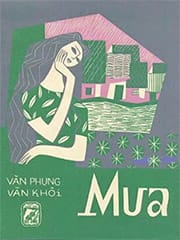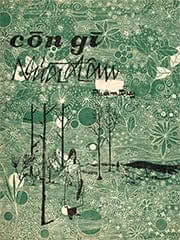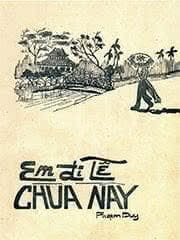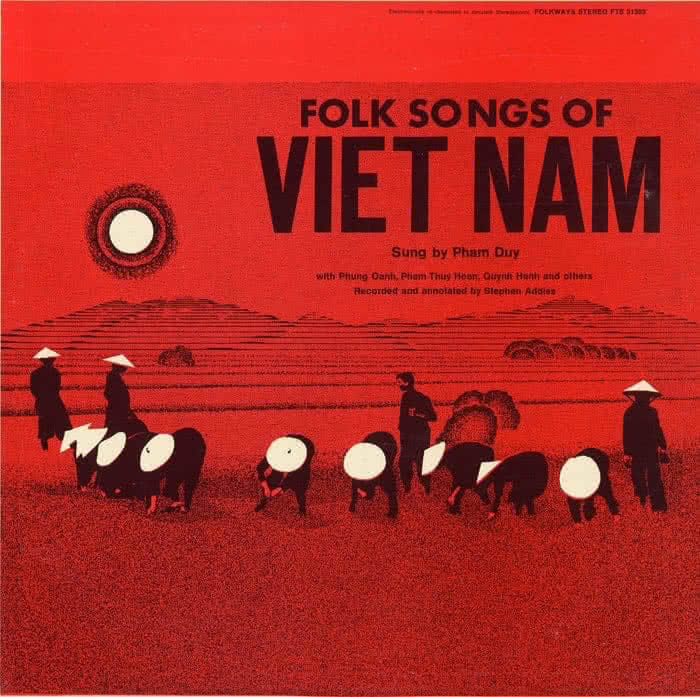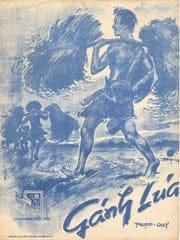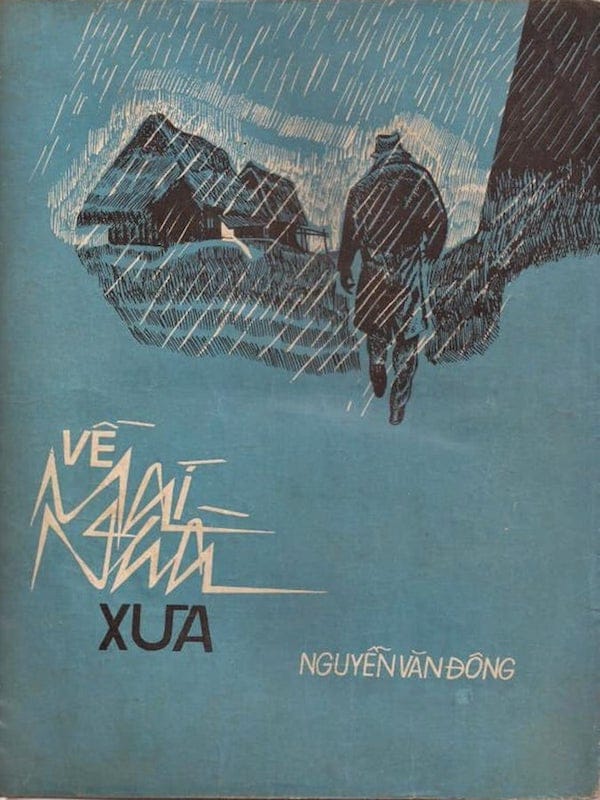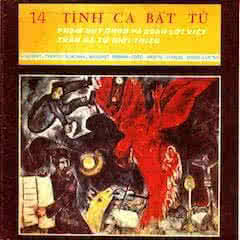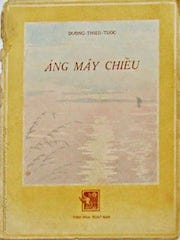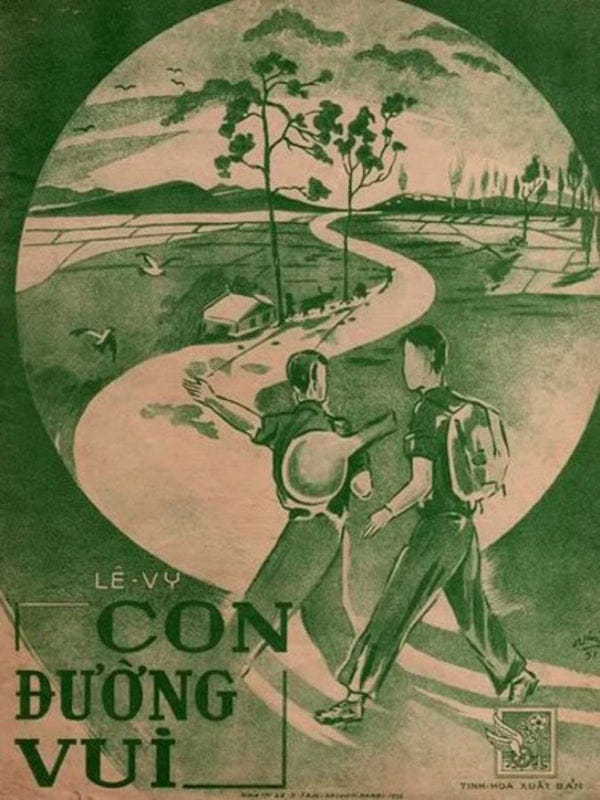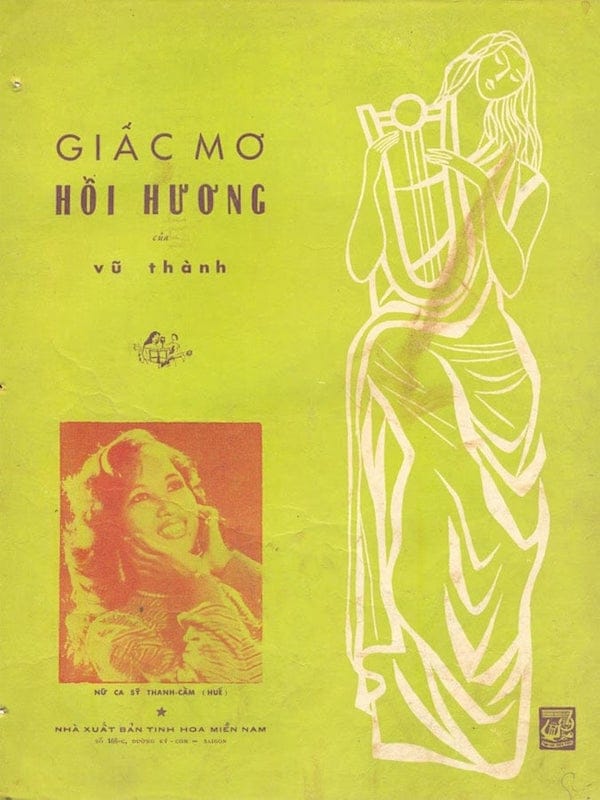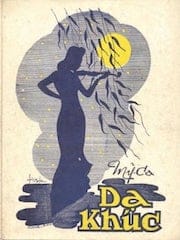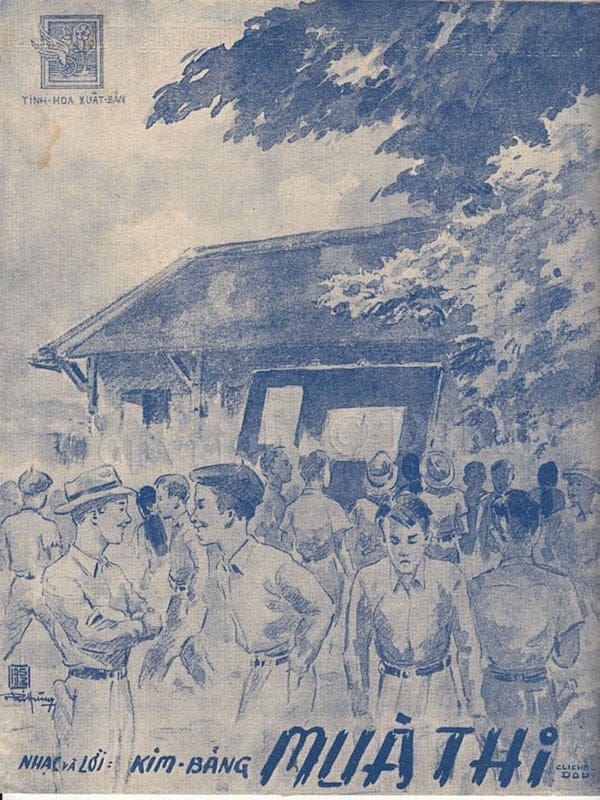Một bản nhạc càng hay thì người ta càng tìm cách diễn dịch nó theo nhiều cách khác nhau, một cảm hứng, gợi ý ban đầu cho nhiều trình diễn, chuyển soạn, phát triển… Như bản Thuyền viễn xứ, có không biết bao nhiêu là người trình diễn, tôi đã nghe nhiều, vocal cũng như instrumental, nhưng tiếng đàn bầu dường như vẫn là, một cách tự nhiên nhất, thanh âm phù hợp để truyền tải cái hồn của Thuyền viễn xứ.
mưa
That’s when the monsoon reverses… Dù cho ai đó cứ viết thơ, làm nhạc: đầu mùa xuân, mùa hạ qua, rồi mùa thu, vào mùa đông… thì quê hương em hai mùa mưa nắng
và cũng chỉ có một thực tế đó mà thôi. Bài hát rất dễ thương của nhạc sĩ Văn Phụng như muốn bắt lấy khoảnh khắc giao mùa, điệu valse trẻ trung hợp với lúc mùa nước trở lại, cây cỏ vạn vật lại sinh sôi…
Mưa đem tươi vui về cho thắm áo nâu,
Mưa cho nương dâu và khoai sắn lên mau,
Mưa như trút sầu, mưa tô lúa đầu,
Mưa rơi qua Bến Hải, Cà Mau…
Một giọng hát rất chi self – assured, self – absorbed như của Lưu Bích, người em gái của ca sĩ Tuấn Ngọc này, rất là quyến rũ, nhưng thực cũng chóng chán…
nhạc sầu tương tư – 2
Mây trôi bơ vơ, mang theo niềm nhớ,
Ánh trăng vàng úa soi bóng hình ai phương trời nào đây…
Bài này nghêu ngao hát và thu âm ngay trên cái laptop cùi bắp đã lâu, chất lượng âm thanh rất là í ẹ, nghe cả tiếng ếch kêu quanh nhà, phải dùng Noise Removal tool của Audacity thì mới tạm nghe rõ lời hát (do noise nhiều nên voice cũng bị distort đi một chút). Bây giờ với máy tính và software thì ai cũng có thể làm ca sĩ karaoke được, mix vài cái sound – tracks: vocal và background music, kéo tới kéo lui, cắt dán một chút, apply vài cái effects là thành recording ngay thôi!
Vốn chẳng bao giờ tự thu âm mình hát nhưng vì rất yêu thích Nhạc sầu tương tư này nên đây là ngoại lệ. Bài này theo tôi rất là Vietnamese – authentic, nét nhạc ngũ cung mang cái fingerprint – “điểm chỉ” Việt Nam mà chỉ cần nghe thoảng qua là biết. Bên trên, từ trái qua phải: thời điểm thu âm tăng dần và chất lượng giọng ca giảm dần.
đừng xa nhau
Đừng đi mau, để mãi mãi,
là chiếc bóng đậm mầu,
còn theo nhau tới muôn đời sau…
Mỗi bản nhạc Việt giống như một bức tranh truyền thần: là ca khúc nên phần ký âm không “đầy đủ”, “chính xác” như truyền thống nhạc cổ điển (Tây phương), tác giả chỉ phác ra giai điệu chính (một số có soạn thêm hòa âm) và để phần diễn dịch tác phẩm âm nhạc đó cho thính giả. Đứng trước một bức tranh truyền thần, sẽ có rất nhiều cách nhận định khác nhau, nhiều khi là trái ngược nhau.
Thế nên mới có vai trò của nghệ sĩ hòa âm và ca sĩ trình diễn: bổ sung thêm nhiều cảm nhận, màu sắc, biến tấu… cho những nét nhạc chính, những điều mà tác giả chỉ gợi ý mà không viết ra (hoặc đôi khi là chính tác giả cũng chẳng có ý đó). Với tôi, cách diễn dịch Thái Thanh luôn luôn là độc đáo và duy nhất!
đường em đi
Đường em có đi, hằng đêm bước qua,
nở những đoá thơ, ôi dị kỳ…
Một tác phẩm nữa của nhạc sĩ Phạm Duy – Đường em đi mà tôi ngờ rằng là được phát triển bằng cùng một “thủ pháp” với các bản Còn gì nữa đâu, Đừng xa nhau. Cả ba bản nhạc như là những “bài tập” đặc sắc sau thời gian học nhạc lý ở Pháp, Phạm Duy học chung lớp với Trần Văn Khê, nhưng chỉ hơn năm thì bỏ học về nước, như lời ông nói: để sáng tác theo kịp với hơi thở của cuộc sống, của thời cuộc
. Còn anh học trò chăm chỉ Trần Văn Khê về sau trở thành giáo sư nghiên cứu âm nhạc.
Những bản nhạc tình chung chung, mông lung thế này chỉ là phương tiện để tác giả gởi gắm cảm xúc từ ý nhạc, những cảm xúc không tên (hãy nghe thêm phần piano arrangement rất hay), nên cũng chẳng quan trọng lắm về ca từ, Đường em đi hay Đường em chẳng đi, Còn gì nữa đâu hay Không còn gì nữa đâu… Hình bên: ảnh ông cụ những tháng ngày gần đây, trông vẫn rất tinh anh ở cái tuổi ngoài 90, vẫn còn xuất hiện và diễn thuyết về âm nhạc, tuy rằng ít hơn trước.
còn gì nữa đâu
Còn gì nữa đâu, tình chôn đã lâu!
Còn gì nữa đâu, mà phải khóc nhau?
Một thu âm rất mộc và đầy chất fantasy của ca sĩ Kim Tước, Còn gì nữa đâu – Phạm Duy. Lần đầu nghe bản này, tôi thực sự ngạc nhiên khi thấy một ca sĩ nổi tiếng bài bản, trường lớp như Kim Tước lại có thể “fantasy” đến vậy, một thu âm tuyệt vời!
Phải nghe version này và phần chuyển soạn cho piano của nhạc sĩ Võ Tá Hân thì mới nhìn rõ cái “dụng ý” và “dáng nhạc” của tác giả, những giọng ca khác dù rất nổi tiếng và tài năng như Khánh Ly, Lệ Thu cũng chỉ có thể… phá hỏng bài này.
portrait
It is me, turning exactly 32 years old, graphite on paper, drawn by a senior student of École des beaux arts de Gia Định
. Nice painting, I really love it, although the character in the drawing was not in the best mood for a portrait! Just something for me to remember… “the stains of time”.
I’m sorry having to blank out the artist signature, she is a brave one, having chosen the difficult way of becoming an artist, and even among the very small minority who has chosen Vietnamese lacquer painting
for her path!
See a large version here.
em lễ chùa này
Tàn mùa đông, vào chùa bỡ ngỡ,
Tiễn đưa em trong áo quan này…
Mừng đại lễ Phật đản, mừng Đạo pháp và Dân tộc mời các bạn nghe ca khúc: Em lễ chùa này qua giọng ca Thái Thanh. Bài hát phổ thơ Phạm Thiên Thư xuất bản lần đầu trong tập nhạc Phạm Duy: Con đường tình chúng ta đi. Bài thơ kể lại chuyện tình có thật giữa một chú tiểu và một cô bé Phật tử thường lên lễ chùa vào các mùa trong năm, cả hai cùng vào độ tuổi 16 trăng rằm:
Đầu mùa xuân cùng em đi lễ, lễ chùa này vườn nắng tung bay… mùa hạ qua cùng em đi lễ, trái mơ ngon đồi gió mơn man…
Về sau cô bé chết trong chiến tranh loạn lạc và được chôn trong chính ngôi chùa đó: tàn mùa đông vào chùa bỡ ngỡ, tiễn đưa em trong áo quan này…
Về nhà sư hoàn tục Thích Tuệ Không – Phạm Thiên Thư (có phải là ông xuất gia tại chính ngôi chùa cô bé thường đi lễ!?), ông thật sự là ảo thuật gia của thể lục bát, một nhà “tu hành” kiêm người viết thơ tình thượng hạng, tác giả những bài thơ khác đã được Phạm Duy phổ nhạc: Ngày xưa Hoàng thị, Đời gọi em là đóa hoa sầu, Đưa em tìm động hoa vàng, 10 bài Đạo ca… như chính ông đã thừa nhận: Hạc rằng: thưa bác Thiên Thư, Mặc chi cái áo thiền sư ỡm ờ!
dân ca mới
Chiều về, chiều về trên cánh đồng xanh,
Có nàng gánh lúa cho anh ra đi diệt thù, u hù,
Từ ngày chinh chiến mùa Thu…
Hồi ký Phạm Duy có nhắc đến việc xây dựng những sáng tác âm nhạc mới dựa trên dân ca, chính thức thì trong những cuộc trao đổi, học tập kinh nghiệm với các chuyên gia TQ tại chiến khu Việt Bắc (các nhạc sĩ “Bát Nhất” đã rất thành công trong thể loại này), ý tưởng đó đã được nêu ra, và khái niệm “dân ca mới” được đặt tên.
Dĩ nhiên, các nhạc sĩ Tân nhạc đã sáng tác nhiều tác phẩm mang âm hưởng dân ca lâu từ trước, nhưng biến nó thành một trào lưu, một phương pháp thì buồn thay không có mấy người thành công: Phạm Duy, Nguyễn Xuân Khoát… nằm trong số ít những tác giả tạo ra được nhiều tác phẩm thành danh còn lại đến ngày hôm nay. Hồi ký Phạm Duy cũng nêu rõ:
-
Dùng chuyển hệ ngũ cung (metabole) để không giới hạn giai điệu trong một làn điệu dân ca duy nhất.
-
Ca từ chủ đạo vẫn là lục bát, nhưng linh động, thêm thắt để phù hợp nhạc điệu.
Nếu những nguyên tắc sáng tác (bên đây) chỉ đơn giản có vậy, tại sao chỉ có một số ít người làm được? Nó gợi cho tôi nhớ đến những lĩnh vực khác, như IT, nơi có quá nhiều suy nghĩ hình thức và có rất rất ít người được việc! Lý do tưởng chừng đơn giản nhưng không phải ai cũng hiểu. Tôi cá có nhiều người sẵn sàng tỏ ra “hiểu”, “biết” Phạm Duy mà chưa nghe lấy được một chục ca khúc của ông, mà giả sử có nghe đi nữa thì cũng chắc gì đã hiểu?
Đến hôm nay, những ca khúc dạng này được thế giới biết đến như là “Vietnamese folksongs” (như một ví dụ ở đây), kỳ thực chúng là những “dân ca mới”, nghe có vẻ cũ mà không phải cũ, nghe có vẻ là dân ca mà lại không phải dân ca… Chàng về, chàng về nay đã cụt tay, Máu đào đã nhuốm trên thây bao nhiêu quân thù, u hù, Từ ngày chinh chiến mùa Thu…
Rất nhiều những “dân ca mới” của Phạm Duy ghi lại một giai đoạn lịch sử đầy bi thương và hào hùng, những ca khúc đã sống trong lòng bao nhiêu thế hệ: Nhớ người thương binh, Dặn dò, Ru con, Người lính bên tê, Đường ra biên ải, Mười hai lời ru, Mùa đông chiến sĩ, Nhớ người ra đi, Tiếng hát trên sông Lô, Nương chiều, Bao giờ anh lấy được đồn Tây (Quê nghèo), Bà mẹ Gio Linh, Về miền Trung, Gánh lúa…
dưới giàn hoa cũ
Lại tiếp tục về giọng ca Thái Thanh. Phải nói thật cái gu “chất giọng” của tôi khá là hẹp… giọng nữ thì phải như Thái Thanh, Hà Thanh, giọng nam thì phải như Anh Ngọc, Tuấn Ngọc (tức là nam phải ra nam, nữ phải ra nữ, không có chỗ cho các loại Đàm, Đan, Lam… của thời bây giờ).
(Hình trên: bộ ba danh ca, từ phải sang: Thái Thanh, Lệ Thu, Khánh Ly). Tiếng hát Thái Thanh thường đi liền với nhạc Phạm Duy, nhưng bà cũng hát khá nhiều các tác phẩm của những nhạc sĩ khác. Từ khi nghe giọng ca Thái Thanh đến bây giờ, thú thật chưa thấy bài nào mà bà hát không hay (đó cũng có thể chỉ là “natural bias”).
Hai ca khúc nhẹ nhàng: Về mái nhà xưa – Nguyễn Văn Đông và Dưới giàn hoa cũ – Tuấn Khanh. Khi xưa, riêng thích hai bài này còn vì những lời ca phảng phất một phong vị rất chi Tự lực văn đoàn: về đây mây nước đêm thâu lạnh lùng, vườn dâu thưa lá ngại nỗi tương phùng…
, hỏi tôi những chiều buồn mây tím xây thành, có thương hoa thắm mong chờ không anh…
nước mắt rơi
Nhạc tình Phạm Duy ít khi chung chung, mông lung, càng không bao giờ trừu tượng như nhạc Trịnh. Nhưng mỗi khi tác giả chuyển sang một cái mood có vẻ hoang vắng, xa vời… ta biết là ông đang đi tới những khúc quanh trên con đường sáng tác của mình: Cành hoa trắng, Thu ca điệu ru đơn, Nước mắt rơi, Đường chiều lá rụng…
Những lúc ấy, “nhạc tình” của ông không còn là về một mối tình cụ thể nào nữa, có chăng chỉ là cái cớ để tác giả bộc lộ một tâm trạng mênh mang khi đứng giữa những “ngã ba đường”. Như khi nghe Cành hoa trắng, ta có thể hiểu đó là tâm trạng (và lý do?) lúc ông từ bỏ chiến khu để “dinh tê về thành”.
“Thiên đường”, “trần gian”, “tiên nữ”, “cành hoa trắng”… cũng dể biết nó ẩn dụ cho những điều gì). Bài Nước mắt rơi này sáng tác ở Sài gòn năm 1961, nó có vẻ nói về tình yêu, mà thực chẳng có liên quan gì tới yêu đương, nó như một đoạn chuyển, dường báo hiệu thực tế xã hội giai đoạn tiếp theo đó, một thực tế mà tác giả đã phản ứng bằng cách soạn Tục ca và Vỉa hè ca!
làm sao có em
Ai đã từng đi qua tuổi ngây thơ mà không say mê bài hát này, là nhạc phim The Godfather, nhưng giờ tôi mới biết tới một “diễn dịch” lời Việt khác của Phạm Duy, mà giả sử như bây giờ có một bài hát với lời như thế, không biết Bộ VHTT có duyệt cho lưu hành không:
Làm sao có em để ấm giường êm trong một đêm mềm. Ðể ta ngất ngây một giấc mộng ngoan mơ màng ảo huyền… Làm sao có em để cháy giường loan soi lửa lên tường. Một đôi rắn hoang vội cuốn vào nhau không rời bàng hoàng…
Điều tôi thích ở âm nhạc (cũng như ở con người Phạm Duy) là… nó không phải ràng buộc vào một khuôn khổ nào cả. Một con người phong phú, đa dạng đến thế hẳn nhiên không nằm trong cách đánh giá của những kẻ tầm thường, những người không tự vượt qua được suy nghĩ hình thức sơ đẳng, nhảm nhí, những kẻ chỉ biết dùng thông tin một chiều để chứng minh những nhận định tầm phào.
Nhạc của ông có thể hàn lâm, có thể dân dã, có thể cao siêu, có thể dung tục… Nó cover một khoảng rất rộng đủ mọi nội dung, thể loại, nguồn gốc… Âm nhạc Phạm Duy không hẳn là dễ, nhưng với “popular music” – nhạc phổ thông, thái độ của ông rất là thoải mái, ai hát nhạc ông cũng được, giọng Kim tốt, mà giọng Mộc, Thủy, Hỏa… cũng tốt ça va tout!
. Ông đặt rất nhiều lời cho các ca khúc phổ thông, kể cả bài Happy Birthday lúc ở Mỹ như sau:
– Mừng cả vạn người di cư, cuộc đời tiền vào có dư. Ðể rồi có con, dân bầu, làm tổng thống Mỹ mai sau (biết đâu).
– Wish all the refugees, our life will be easy. And wish some child will be, the President of this country.
trái tim còn trinh
Hôm nay tình cờ được nghe lại bài hát này, chợt nhận ra thoang thoáng mùi ngũ cung Nhật Bản trong nhạc điệu (nếu nó đậm đặc kiểu như Mùa hoa anh đào thì đã là hiển nhiên rồi). Một bài hát mà tôi đã “bị” nghe ra rả suốt ngày vào quãng những năm 12 ~ 15 tuổi (thời cuối của các giọng ca Nhã Phương, Bảo Yến…). Về nhà google thì hóa ra chính là bác Phạm Duy nhà ta đặt lời Việt cho ca khúc Nhật Bản này, bác mà đặt lời Việt tràn lan thế này thì ai còn biết bác là nhạc sĩ sáng tác vĩ đại nhất Việt Nam nữa bác ơi!?
Tài liệu của nhạc sĩ Phạm Duy cũng xác nhận, hai ca khúc “thành công” nhất (tính theo doanh số) suốt những năm 90s ở hải ngoại chính là bài này và Mười năm tình cũ (Trần Quảng Nam)! Tiếc là chưa tìm được bản nhạc Nhật gốc, cái mùi ngũ cung bản địa dĩ nhiên là cứ nhạt dần qua mỗi lần chuyển ngữ, qua những giọng ca thể hiện khác nhau!
bóng chiều xưa
Ca khúc rất phổ biến của nhạc sĩ Dương Thiệu Tước do chính vợ ông hát. Hãy nghe giọng của nữ danh ca một thời, một trong những giọng ca nữ đầu tiên của Tân nhạc, Minh Trang, mẹ ca sĩ Quỳnh Giao hát những ca từ do chính bà đặt. Nếu không nghe phần thoại giáo đầu thì có ai nghĩ đây là giọng một “cụ bà” 60 tuổi (tại thời điểm thu âm)? Giờ thì không còn thích cái “tango” này như xưa nữa, nhưng vẫn thích cái lời ca với “yêu vận” trong những câu lẻ nhịp…
Một chiều ái ân say hồn ta bao lần. Một trời đắm duyên thơ cho đời bao phút ơ thờ. Ngạt ngào sắc hương, tay cầm tay luyến thương. Đôi mắt em nhìn càng say đắm mơ màng nào thấy đâu sầu vương. Một chiều bên nhau, một chiều vui sống quên phút tang bồng. Anh ơi nhớ chăng xa anh em hát khúc ca nhớ mong.
Một chiều gió mưa, em về thăm chốn xưa. Non nước u buồn nào đâu bóng cố nhân lòng xót xa tình xưa. Lâng lâng chiều mơ, một chiều bâng khuâng đâu nguồn thơ. Mây vương sầu lan, gió ơi đưa hồn về làng cũ, nhắn thầm lời nguyện ước trong chiều xưa. Thương nhau làm chi, âm thầm lệ vương khi biệt ly. Xa xôi còn chi, vô tình em nhớ mối duyên hờ. Tình như mây khói, bóng ai xa mờ.
áng mây chiều
Tiếp tục cái mood serenata… mỗi khi nghe lại nhạc cũ mà có cái cảm giác “exotic” là tôi lại thấy bực mình, một cái bực mình thú vị, lại tìm thấy cái gì đó mới trong những thứ ngỡ đã biết rồi. Ca khúc Áng mây chiều, giọng ca Quỳnh Giao, tác giả không ai khác hơn chính là step – father của cô, nhạc sĩ Dương Thiệu Tước.
NS Dương Thiệu Tước khi viết nhạc thất cung thì nhạc ông “rất Tây”, khi viết nhạc ngũ cung thì lại “rất Ta”, nên không có gì lạ khi nghe lại nhạc ông, đôi khi lại cảm thấy “exotic”, vì ông vừa “Tây hơn” vừa “Ta hơn” chúng ta!
Về ca sĩ Quỳnh Giao: cũng từ cái lò ban nhạc Tiếng Tơ Đồng với Mai Hương và Kim Tước, cùng dưới sự dẫn dắt của nhạc sĩ Hoàng Trọng, cũng một trường phái ca hát, một chất giọng bắt đầu từ Thái Thanh. Sau này ở hải ngoại, Mai Hương, Kim Tước và Quỳnh Giao tái lập Tiếng Tơ Đồng như là một biểu tượng.
Exotic tiếng Anh có nghĩa là “đẹp một cách kỳ lạ”!
con đường vui
Nhiều người thường bảo Tân nhạc sao toàn những bài hát ảo não, ủy mị, ngậm ngùi, trông ngóng, hoài hương, xa quê, xa vắng… tôi cho rằng không phải. Tân nhạc đâu phải chỉ có vậy, còn có rất nhiều ca khúc thiếu nhi, ca khúc học sinh, thanh niên ca, hành khúc, tình ca, ca khúc hướng đạo, âm nhạc Phật giáo, Công giáo, nhạc trẻ, nhạc phản chiến… Một thực tế, thực thể sống động, phong phú, nhiều màu sắc đến như vậy không chịu khó tìm hiểu, không lắng nghe mà cứ phán bừa thì e rằng hồ đồ.
Khi mà đối phương đang ở trên những Con đường không vui – La rue sans joie – Street without joy thì chúng ta có rất nhiều những bài như ca khúc Con đường vui này! Tôi không biết lúc đó bài hát phổ biến như thế nào, nhưng ai có dịp làm quen với các tổ chức Hướng đạo, Thanh niên Phật tử thì sẽ biết nhiều những ca khúc như thế này vẫn còn lưu truyền. Như thế hệ trước, có thể không biết cái tên Con đường vui, nhưng họ vẫn nhớ những lời ca đầy trẻ trung, phóng túng: giang hồ không bờ không bến, đẹp như kiếp Bohémien…
hướng về hà nội
Trong một post trước đã nhắc đến giọng hát Kim Tước, thực sự thì ít người biết đến và yêu thích giọng ca điêu luyện này. Hướng về Hà Nội của nhạc sĩ Hoàng Dương là Kim Tước hát đầu tiên (1954), do nhạc sĩ Hoàng Trọng giới thiệu (Hoàng Dương, Hoàng Trọng là bạn thân, hai người có nhiều liên hệ dù sau này ranh giới chính trị ngăn cách, Hoàng Dương cũng là người viết lời cho ca khúc Hoàng Trọng: Nhạc sầu tương tư mà tôi rất yêu thích).
Giờ thì ai cũng biết bài này do có quá nhiều chương trình lăng – xê Hà Nội, nhưng đương thời, miền Bắc thì cấm bài hát lấy lí do tiểu tư sản, ủy mị
, miền Nam thì cấm vì vừa ngay sau đợt di cư 1954 lại rầm rộ dấy lên phong trào, tâm tưởng Hướng về Hà Nội, nói chung là cấm, đơn giản là ở đâu cũng bị cấm, chính trị là như thế! Là người hát đầu tiên, Kim Tước đến tận bây giờ vẫn là người hát bài này hay nhất! Cũng trong trào lưu Hướng về Hà Nội này, Kim Tước còn hát Giấc mơ hồi hương, nhạc sĩ Vũ Thành: ta nhớ thấy “em” một chiều chớm thu, dáng yêu kiều của ngày đã qua…
dạ khúc – mỹ ca
Sở dĩ blog này post toàn nhạc vì… chẳng có mấy khi nghe nhạc. Cái “nghe nhạc” của tôi không phải là ngồi xuống mở loa lên nghe (nhạc ở trong đầu mình chứ không tại mấy cái đĩa). Tại một không gian, thời điểm, tại một cái mood nào đó, tưởng đến một giai điệu phù hợp tâm trạng (ví như các raga Ấn độ có loại chỉ nghe buổi sáng hay trưa, tối, hay một mùa nào đó trong năm).
Vì bản tính “mau nhớ mau quên” nên cần một cái index để ghi chú thông tin về những bản nhạc đã nghe được ở đâu đó và đôi khi nhiều năm chẳng bao giờ mở loa lên nghe lại! Gần đây hay có cái mood “dạ khúc” – serenade – serenity (tạm đặt tên như thế).
Tân nhạc VN có khá nhiều dạ khúc nhưng hay nhất theo tôi là bài này của Nguyễn Mỹ Ca, trình bày ở đây qua hai giọng ca, một giọng “tuyệt kỹ” Thái Thanh và một giọng “thô mộc” rặt Nam bộ Trần Văn Trạch. Một giai điệu tuyệt đẹp: đàn ai lên cung oán, tang tình, gieo hờn, đàn ai ngân theo gió, xế xang, gieo buồn…
Rất ít được biết về cuộc đời tác giả, ông hy sinh năm 46, sử chính thức vẫn nhắc đến xưởng quân khí mang tên Mỹ Ca của “nhạc sĩ yêu nước” (sic) Nguyễn Mỹ Ca.
mùa thi
Một bài hát rất ít người còn biết, post ở đây làm tư liệu. Ngay cả thế hệ ba mẹ tôi cũng không biết bài này, phổ biến vào những năm 51, 52, khi đó họ mới bắt đầu tiểu học. Đây là bài hát yêu thích của tôi lúc còn ở cấp 1, 2, rất đặc biệt với cái giai điệu và lời ca tinh nghịch học sinh của nó! Nếu có điều gì để nói về âm nhạc trước 75 thì không phải là một nhận định hay, dở… mà là sự phong phú phản ánh tính “đa dạng sinh học” của cái xứ Indochinois này!
May we see the differences between us and all that we share in common…
để “ủng hộ” tính “đa dạng” đó, sau Mùa thi, mời các bạn tiếp tục với Nỗi buồn hoa phượng, ca khúc mùa tan trường! Và không có gì ngạc nhiên khi Mùa thi là ca khúc nổi tiếng nhất của một người mang cái tên Đỗ Kim Bảng!
xa quê
…Ôi cánh chim chơi vơi,
triền miên áng mây trôi, hoàng hôn rơi rơi.
Lặng nhìn vầng dương phai,
nhớ nhung vườn trăng soi, nay đã xa vời…
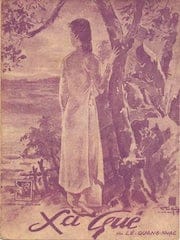
Nghe bài này một lần duy nhất cách đây đã mấy chục năm, khi còn rất nhỏ, thoáng qua không biết tác giả là ai, nhưng đã để ý thấy sự khác biệt nên gần đây cố lần lại lai lịch bài hát. Một ca khúc đơn giản, nhưng là loại đơn giản chỉ gặp trong không gian, thời gian của các bậc đàn anh: Nguyễn Hữu Ba, Nguyễn Văn Thương, Thông Đạt, Thẩm Oánh, Lê Trọng Nguyễn… và phần nào của thế hệ kế tiếp: Phạm Mạnh Cương, Hoàng Nguyên…
Rất nhiều ca khúc tôi chỉ biết hát hoặc ghi nhớ chứ không hề biết tác giả, thậm chí là tiêu đề, vì trước đây làm gì có internet đâu để mà tra cứu, giờ thì cập nhật thông tin đã tương đối dễ dàng hơn… Ca từ bài này có phần “sáo” nếu không đặt ca khúc đúng vào thời gian của nó, thời của Đêm đông, Ai về sông Tương… nhạc điệu thể hiện hoàn hảo cái mood “serenata” – khúc nhạc ban chiều!
(Khá nhiều những thu âm ở hải ngoại là hòa âm computer, hay là lạm dụng kỹ thuật máy tính để mix lại những thu âm có sẵn, đơn giản vì những home – brew recording như thế tiện lợi và ít tốn kém hơn. Tuy vẫn thể hiện được dáng nhạc với tai nghe rành rõi nhưng những âm thanh synthetized làm bản nhạc trở nên vô hồn, mất đi sức truyền cảm!)


